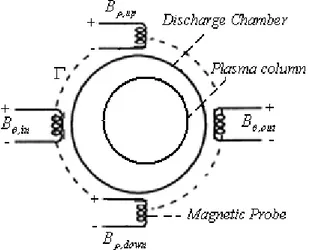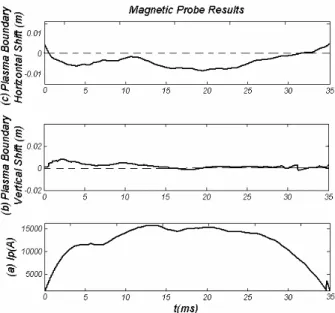Brazilian Journal of Physics, vol. 40, no. 3, September 323
Measurement of the Plasma Boundary Shift and Approximation of the Magnetic Surfaces on the
IR-T1 Tokamak
A. Salar Elahi
Physics Department, Faculty of Engineering, Islamic Azad University, Saveh Branch, Saveh, Iran.
M. Ghoranneviss
Plasma Physics Research Center, Science and Research Branch, Islamic Azad University, P.O. Box 14665-678, Tehran, Iran
(Received on 15 February, 2010)
In this research we measured the plasma boundary shift using array of magnetic pick-up coils on the IR-T1 tokamak. Also we approximated the magnetic surfaces by an equilibrium calculation. Firstly, four magnetic probes were designed, constructed, and installed on outer surface of the IR-T1 tokamak chamber and then plasma boundary displacement measured from them. On the other hand, magnetic surfaces approximated by equilibrium calculation of the Grad-Shafranov equation based on expansion of free functions as quadratic in flux function.
Keywords: Tokamak, Plasma Boundary Shift, Magnetic Surfaces.
1. INTRODUCTION
To a very good approximation in tokamaks, the problem of achieving toroidal equilibrium separates into two parts. First, the magnetic configuration must provide radial con-finement, i.e., radial pressure balance in the poloidal plane so that the pressure contours form closed nested surfaces. Second, the configuration must compensate the radially out-ward expansion force inherent in all toroidal geometries, i.e., toroidal force balance. But, in the second one, plasma may intend to shift inward or outward, which is very dangerous for tokamak plasma. Therefore, plasma equilibrium study is one of the fundamental problems of the magnetically con-fined plasmas. There are many available global solutions of the steady state magnetohydrodynamics equations, in partic-ular, the Grad-Shafranov equation. Control of plasma posi-tion plays an important role in plasma confinement and to achieve optimized tokamak plasma operation. Accurate de-termination of the plasma position during confinement time is essential to transport it to a control system based on feed-back. Over the years different methods have been developed to analyze the equilibrium problems and determination of both plasma boundary shift and magnetic surfaces [1-21].
In this paper we presented magnetic probes method for measurement of the plasma boundary shift and approxima-tion of magnetic surface based on analytical soluapproxima-tion of the Grad-Shafranov equation on the IR-T1 Tokamak, which is a small, air core, low beta and large aspect ratio tokamak with a circular cross section, (see Table 1). Details of the mag-netic probes method for the determination of plasma bound-ary shift will be discussed in section 2. Approximation of magnetic surfaces based on analytical solution of the Grad-Shafranov equation will be presented in section 3. Experi-mental result also will be presented in section 4. Summary and conclusion are also will be presented in section 5.
2. MAGNETIC PROBES TECHNIQUE FOR THE MEASUREMENT OF PLASMA BOUNDARY SHIFT
Because of dependence of the plasma position and plasma current distribution to the magnetic field distributions around the plasma, magnetic pickup coils can give us information about the plasma position or plasma boundary shift. Poloidal and normal components of the magnetic fields distribution in the quasi-cylindrical coordinates (r,θ,φ) around the circular cross section plasma are [1]:
Bθ=µ0Ip 2πb−
µ0Ip 4πR0×
n
lnab+1− Λ+12
a2
b2+1
−2Rb02∆R
o
cosθ, (1)
Br=−4µπ0IpR0×
n
lnab+ Λ+12a2
b2−1
+2R0∆R
b2
o
sinθ, (2)
whereΛ=βp+li/2−1 is the Shafranov parameter anda,b,
Ip,R0,βp,li, and∆Rare the plasma minor radius, chamber minor radius, plasma current, chamber major radius, poloidal beta, internal inductance, and plasma boundary horizontal shift, respectively. Therefore, by rearranging the above equa-tions the following relation for the horizontal shift of the plasma boundary is obtained:
∆R= a2
4R0
n
b2 a2−1
−2 lnab
o
+
πb2
2µ0Ip
n
∆B1θ
1−a
2
b2
−∆Br
1+a2 b2
o
. (3)
As observable, this relation depends only on the plasma cur-rent and magnetic fields distribution. Also the vertical dis-placement of the plasma boundary is [2]:
∆Z=πb 2
µ0Ip
∆B2θ (4)
Equations (1) and (2) are accurate for the low beta, large as-pect ratio, and circular cross section tokamaks as IR-T1, also:
∆B1θ=Bθ(θ=0)−Bθ(θ=π),
∆B2θ=Bθ(θ=3π/2)−Bθ(θ=π/2),
∆Br=Br(θ=π/2)−Br(θ=3π/2).
324 A. Salar Elahi and M. Ghoranneviss
According to this approach, four magnetic probes were de-signed, constructed, and installed on the IR-T1 tokamak, two magnetic probes were located on the circular contourΓof the radiusb=16.5cmin angles ofθ=0 andθ=πto detect the tangential component of the magnetic fieldBθ and two
magnetic probes are also located above,θ=π/2, and below, θ=3π/2, to detect the normal component of the magnetic fieldBr (see the Fig. (1)).
By substituting the poloidal and normal components of the magnetic fields which are measured by the four mag-netic pickup coils (after compensation and integration of their output) in Equations (3) and (4)(∆B2θmeasured using
the poloidal Mirnov coils), horizontal and vertical displace-ments of the plasma boundary were determined. Experimen-tal results will be presented in the section 4.
FIG. 1: Positions of the four magnetic probes on outer surface of the IR-T1 tokamak chamber.
3. APPROXIMATION OF THE MAGNETIC SURFACES BASED ON ANALYTICAL SOLUTION OF THE
GRAD-SHAFRANOV EQUATION
Maxwell’s equations together with the force balance equa-tion from MHD equaequa-tions, in the cylindrical coordinates (R,Z)reduce to the two-dimensional, nonlinear, elliptic par-tial differenpar-tial equation, or Grad-Shafranov equation [3]:
∆∗ψ=−µ 0R2
d p dψ−F
dF
dψ, (6)
where
⇀ B= 1
R ⇀
∇ ψ×eˆφ+
F Reˆφ,
µ0
⇀ J= 1
R dF
dψ~∇ψ×eˆφ− 1 R∆
∗ψeˆ
φ, (7)
and p(ψ) andF(ψ) are two free functions, and where µ0 andJare the vacuum permeability and plasma current den-sity respectively. Many authors solved the Grad-Shafranov
equation by expanding the free functions on different order inψ. In this section, we presented quadratic order (which proposed by Guazzotto [4]), and approximated on the IR-T1. If we choose the free functions to be quadratic inψas [4]:
p=p0 ψ2/ψ20
,
F2=R20B20
1+b0 ψ2/ψ20
, (8)
whereψ0,p0,b0are the values ofψ,p, andFon magnetic surfaces axis,R0is the tokamak major radius, andB0is the vacuum toroidal field.
The Grad-Shafranov equation reduces to:
∆∗ψ=
−
R20B20 ψ2
0
b0+β0
R2 R20
ψ, (9)
where β0 =2µ0p0/B20. With normalizing variables as
R2/R2
0=x, andZ/a=y, Eq. (9) can then be written as: 4ε2x∂
2ψ
∂x2 +
∂2ψ
∂y2 + (αx+γ)ψ=0, (10)
whereε=a/R0, is the inverse aspect ratio, and
α=
aR
0B0
ψ0
2
β0, γ=
aR0B0
ψ0
2
b0. (11) The solution of Eq. (10) in cylindrical coordinates(R,Z) can be written as:
ψ=
∑
m
Xm(ρ)Ym(y), (12)
wherex=−i ε/√αρ, and for up-down symmetric case,
Ymobtained as:
d2Ym
dy2 +k2mYm=0, Ym(y) =cos(kmy).
(13)
AlsoXm(ρ)can be written as: d2Xm
dρ2 +
hλ
m
ρ −14
i
Xm=0,
Xm(ρ) =amWλm,µ(ρ) +bmMλm,µ(ρ),
(14)
whereλm=−iγ−k
2
m
4ε√α,Wλm,µ(ρ), andMλm,µ(ρ)are the Whit-taker functions, and in this modelµ=1/2.
Guazzotto proposed only three terms form, and thenψcan be written as:
ψ(ρ,y) = 3
∑
m=1
amWλm,1/2(ρ) +bmMλm,1/2(ρ)
cos(kmy), (15)
Brazilian Journal of Physics, vol. 40, no. 3, September 325
from boundary conditions. The boundary conditions for the points of inner, outer, and top of the plasma cross section are (see Figure (2)):
ψ(R0+a,0) =0, ψ(R0−a,0) =0,
ψ(R0,a) =0, ∂∂ψR(R0,a) =0,
(16)
whereais the plasma radius, and condition for right convex-ity on the inboard midplane is:
1 Rc =
∂2ψ
∂Z2(R0−a,0)
∂ψ
∂R(R0−a,0) =−1
a, (17)
also two conditions (one defining the location of the mag-netic axis (Raxis) and the other the normalization forψ on magnetic axis) are:
∂ψ
∂R(Raxis,0) =0,
ψ(Raxis,0)
ψ0
=1. (18)
FIG. 2: geometry used for the boundary conditions.
These are seven boundary conditions for seven unknown co-efficients (am,bm,Raxis).
But for other three coefficients, by settingk1=0 (the sim-plest solution for GSE independent ofZ), and introduce one approximate value for the γ (γ≈2(q/ε)2 δBφ/Bφ,
neg-ative for diamagnetism plasma, and where q=aBφ/R0Bθ
andεare the safety factor and inverse aspect ratio respec-tively), and assuming thatk2 be imaginary and k3 be real, the values of α, k2, k3can be approximated by minimiz-ing the error function between traditional plasma shape (R=
R0+acosθ, Z=a sinθ), and analytical plasma shape. Ap-propriate error function between them defined as follow [4]:
ErrorFunction=
∑i
√
[RA(θi)−RT(θi)]2+[ZA(θi)−ZT(θi)]2
∑i
√
R2
T(θi)+Z2T(θi)
,
where subscripts (AandT) indicates the analytical and tra-ditional plasma shape parameters respectively, and sum in minimum include 3 angles (0, π/2, π) for our purpose (cir-cular plasma).
In general by minimizing the error function (e.g. by Math-ematica software) as possible to zero, and finding optimal values forα,k2,k3, and also solving seven equations for the boundary conditions (Eqs. (16), (17), and (18), six unknown
coefficients (am, bm), moreoverRaxiscan be find. Therefore the approximated magnetic surfaces can be plotted by substi-tuting these nine coefficients and also input parameters asIp, α,R0, andεin Eq. (15). For example the magnetic surfaces att=15mscorrespond to approximatedγ≈ −0.32 be shown
in the Fig. (5).
FIG. 3: Magnetic Surfaces Approximated by the Analytical Method at t=15ms in Target Shot correspond toγ≈ −0.32 on IR-T1 Toka-mak, Displacement of the magnetic surfaces relatively to the plasma boundary observable.
4. EXPERIMENTAL RESULT
326 A. Salar Elahi and M. Ghoranneviss
Parameters
Value
Major Radius
45 cm
Minor Radius
12.5 cm
Toroidal Field
〈
1.0 T
Plasma Current
〈
40 kA
Discharge Time
〈
35 ms
Electron Density
0.7-1.5
×
10
13cm
−3Table 1. Parameters of the IR-T1 Tokamak
FIG. 4: (a) Plasma current, (b) Time interval of the Plasma Bound-ary Vertical Displacement, and (c) Time Interval of the Plasma Boundary Horizontal Displacement measured by the magnetic probes.
5. SUMMARY AND CONCLUSION
In this research we measured the plasma boundary shift using array of magnetic pick-up coils on the IR-T1 toka-mak. Also we approximated the magnetic surfaces by an equilibrium calculation. Firstly, four magnetic probes were designed, constructed, and installed on outer surface of the IR-T1 tokamak chamber and then plasma boundary displace-ment determined from them. The possible minor errors in this research are because of (1) approximation in the mea-surement of magnetic fields distribution because of discrete probes measurement, (2) possible error in the compensation of error fields, (3) the approximate values chosen forγ, and (4) the errors do not become zero during minimizing the er-ror function.
[1] H. Niomiya and N. Suzuki, Jpn. J. Applied Phys., 21 (9), 1323 (1982).
[2] M. Valovic, Czech. J. Phys., B38, 65 (1988).
[3] J. P. Freidberg, Ideal MHD (Clarendon, Oxford, 1987). [4] L. Guazzotto and J.P.Freidberg, PSFC/JA-07-14, Phys.
Plas-mas, (2007).
[5] C.V.Atanasiu et al., Phys.Plasmas, 11, 3510 (2004). [6] G. S. Lee et al., Nucl. Fusion 41, 1515 (2001). [7] S. H. Seo, Phys. Plasmas 16, 032501 (2009). [8] S. G. Lee et al., Rev. Sci. Instrum. 79, 10F117 (2008). [9] A. J. H. Donne, Nucl. Fusion 47, S337–S384, (2007). [10] F.Najmabadi et al., Fusion Eng.Des.65, 143 (2003). [11] L.Guazzotto et al., Phys.Plasmas 11, 604 (2004).
[12] A. Salar Elahi et al., IEEE Trans. Plasma Science 38 (2), (2010).


